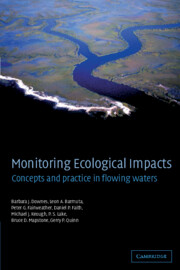Book contents
- Frontmatter
- Contents
- Preface and Acknowledgements
- Part I Introduction to the nature of monitoring problems and to rivers
- Part II Principles of inference and design
- 4 Inferential issues for monitoring
- 5 The logical bases of monitoring design
- 6 Problems in applying designs
- 7 Alternative models for impact assessment
- Part III Applying principles of inference and design
- References
- Index
6 - Problems in applying designs
Published online by Cambridge University Press: 21 August 2009
- Frontmatter
- Contents
- Preface and Acknowledgements
- Part I Introduction to the nature of monitoring problems and to rivers
- Part II Principles of inference and design
- 4 Inferential issues for monitoring
- 5 The logical bases of monitoring design
- 6 Problems in applying designs
- 7 Alternative models for impact assessment
- Part III Applying principles of inference and design
- References
- Index
Summary
Chapter 5 dealt with the ideal design criteria appropriate for the logical detection of impacts. In this chapter, we illustrate why these design criteria are important by outlining the problems that have been faced by ecologists seeking to apply at least some of the principles that were discussed in chapter 5. Many studies were conducted before much was known about good design, but problems in applying monitoring designs have arisen partly from the nature of rivers themselves (chapter 2), partly from the nature of the variables that river ecologists deal with (chapter 10), and partly from institutional and political arrangements that affect the timing and scope of such studies.
Before describing these problems in detail, we first present an historical sketch of the previous attempts at implementing programs for impact assessment and monitoring using biological data in rivers and streams. This brief history lesson illustrates the apparent simplicity and hidden complexities of assessing and monitoring in rivers and streams. We will then elaborate on how each of the three problem areas makes it difficult to implement ideal experimental designs in rivers and streams.
A BRIEF HISTORICAL SKETCH
The vast majority of published field studies of impacts in streams have been directed at investigating pre-existing impacts (see reviews by: Hellawell 1986; Hynes 1960). Many of the earlier studies were aimed at least at corroborating conclusions drawn from observations of large, obvious human impacts and from physicochemical investigations (Fjerdingstad 1964; Forbes & Richardson 1919; Kolkwitz & Marsson 1908; Patrick 1949), and sometimes at establishing that biological variables were detecting changes that had been missed by using physicochemical data alone (reviewed by Wilhm 1975).
- Type
- Chapter
- Information
- Monitoring Ecological ImpactsConcepts and Practice in Flowing Waters, pp. 137 - 163Publisher: Cambridge University PressPrint publication year: 2002

